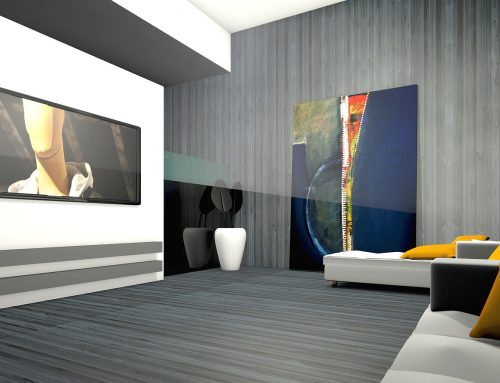Was Sie über das Precomposing in After Effects wissen sollten.
Das Precomposing wird häufig als eine schlecht durchdachte Lösung angesehen, um Ordnungsprobleme zu lösen. Dieser Aussage stimmen wir nicht zu. Vielmehr handelt es sich um einen effektiven Weg, Probleme zu lösen und Projekte in After Effects zu optimieren.

Beim Precomposing handelt es sich um eine Aktion, einen Satz von Layern in einer Komposition auszuwählen und sie einer neuen Unterkomponente zuzuweisen.
Typischerweise erfolgt das Precomposing, indem Sie die Layer einer Komposition auswählen, die gruppiert werden können und sollen sowie im Ebenenmenü Precomposing wählen (Sie können auch die Tastenkombination Strg+Shift+C/Cmd+Shift+C verwenden.) Sie haben zwei Möglichkeiten: Attribute dort zu lassen, wo sie sind oder sie in die neue Komposition zu verschieben. Eine der Optionen ist ausgegraut, wenn mehrere Layer ausgewählt werden, aus Gründen, die im Kleingedruckten der Dialogbox erläutert werden. Wenn Sie sich fragen, was ein Attribut ausmacht, das precomposiert werden soll, ist es so ziemlich alles, was Sie auf dem Layer bearbeitet haben: ein Effekt, eine Maske, Pinselstriche oder sogar Layer Ein- und Ausgangspunkte.
Warum Precomposing wichtig ist.
Je nachdem, wen Sie fragen, ist das Precomposing entweder die Lösung für die meisten Probleme in After Effects oder gehört zu den lästigen Aufgaben, die Sie im Programm erledigen müssen.
Warum also nicht einfach in einer großen Komposition arbeiten. Die Vorteile, die sich daraus ergeben, scheinen vielfältig zu sein. Alle Eigenschaften und Keyframes, die Sie sich wünschen würden, bleiben direkt vor ihnen, Sie müssen nie in einer Teilkomponente graben, um eine Level-Einstellung festzulegen und es gibt keine Schwierigkeiten, die Reihenfolge der Komposition zu verfolgen.
Folgende Gründe sprechen dafür, dass Sie sich auf das Precomposing vorbereiten:
- Zwei Layer synchron halten. Wenn Sie jemals die gleichen Einstellungen an zwei verschiedenen Layer in der gleichen Komposition vornehmen, kann das ein Signal sein, dass die Layer jetzt ein Element umfassen und Sie precomposen müssen.
- Als Lösung für Renderorder-Probleme. Manchmal ist es einfach nicht möglich, eine Renderaktion ohne Precomposing vor einer anderen durchzuführen. Wenn Sie beispielsweise einen Layer maskieren möchten, nachdem Sie Effekte auf sie angewendet haben, müssen Sie die Effekte auf eine Precomposition anwenden und diese dann maskieren.
- Um die Master-Komposition in Ordnung zu halten, sollte dieser selbsterklärend sein. Einer Master-Komposition mit sechs gut organisierten Elementen ist viel nützlicher als eine mit Dutzenden von unterschiedlichen Elementen.
- Wiederverwendung eines Elements. Wenn Sie einen Satz von Layern verwendet haben, um ein Element zu erstellen, von dem Sie denken, dass es wieder verwendet werden könnte oder das ihr Kunde an mehreren Stellen global ändern möchte, ist es sehr sinnvoll, diese Layer als Komposition zu verschachteln. Auf diese Weise können Sie das Element wiederverwenden, indem Sie es einfach in eine neue Timeline ziehen.
- Weil ein Element oder ein Satz von Layern im Wesentlichen ausgeführt wird. Dies ist, falls Sie es nicht wussten, ein großes Ziel. Wenn Sie einen Teil ihrer Aufnahme beenden können, insbesondere wenn es sich um einen renderintensiven Teil handelt, bietet ihnen das Precomposing dieses Teils die Möglichkeit, ihn vorzurendern.
Wenn Sie mit der Idee des Precomposing bereits vertraut sind, ist der letzte Punkt wahrscheinlich der wichtigste, den Sie beachten sollten. Wie Sie später noch sehen werden, profitieren Sie enorm als Designer von einem Mentalitätswechsel, wenn Sie sich von einem Designer, der alles offen lassen will, zu einem Designer entwickeln, der die Vorteile der Fertigstellung eines Objekts versteht, wenn auch nur für den Moment.
Anmerkungen.
Einige andere Compositing-Anwendungen und insbesondere Discreet`s Inferno, scheinen die Bedeutung in Bezug auf wahrgenommene Geschwindigkeit und Leistung in den Schatten gestellt zu haben. Inferno ist leistungsstark und läuft auf angepasster Hardware, aber manchmal merken die Leute nicht, dass es sich nicht wirklich um Echtzeit handelt, selbst Inferno muss rendern. Inferno-Designer werden diese Tatsache verbergen, indem sie im Hintergrund rendern oder verlangen, dass Elemente vorab gerendert werden.
Optionen und Gotchas.
Das Precomposing eines einzelnen Layers mit der Option „alle Attribute initial lassen“ ist relativ einfach. Meistens werden Sie jedoch mehrere Layer über die Option „Alle Attribute verschieben“ precomposen, eine Route, die mit Gefahren verbunden sein kann, wenn Sie nicht aufpassen.
Typische Fehler, die mit diesem Prozess auftreten, sind unter anderem
- Ändert die Dauer und den Versatz der Layer, wie sie in der Timeline erscheinen.
- Es ist nicht vorgesehen, dass einige Attribute vorab zusammengestellt werden müssen, aber nicht alle.
- Es ist schwierig, das Precomposing mehrerer Bearbeitungen rückgängig zu machen.
- Das Verhalten von precomposten Mischmodi und 3D-Transformationen ändert sich je nachdem, ob die Komprimierungstransformationen ein- oder ausgeschaltet sind.
- Verwirrung über die Rekursion: In welchen Fällen wirken sich Bewegungsunschärfe, Frame Blending und komprimierte Transformationsschalter auf verschachtelte Teilkomponenten aus?
Schauen Sie sich jede dieser Situationen genauer an, ebenso wie einige nützliche Strategien für die Arbeit mit ihnen.
Verwirrung bei der Layer Duration.
Im Folgenden demonstrieren wir ihnen das Layer Duration Problem. Durch das Precomposing eines Satzes von Layern, die nicht die gleiche Dauer wie die Quellkomposition haben, werden sie in eine neue Komposition gebracht, deren Dauer derjenigen der Quellkomposition, nicht aber derjenigen der Layer entspricht. Das Ergebnis ist, dass der Precomposing Layer leere Frames am oberen oder unteren Ende der Aufnahme enthält.
Wenn Sie den Offset von Layern mit der Option „alle Attribute“ verschieben precomposen, werden Sie möglicherweise nicht feststellen, dass der Offset auf die Precomposition übertragen wird, während die Master-Komposition einen Layer zeigt, welcher bei Frame 0 zu beginnen scheint.
Sie können die Layer so zuschneiden, dass sie den ursprünglichen Bearbeitungen entspricht, aber es gibt eine bessere Option. Dies funktioniert am besten, wenn Sie die Option „Zeit“ aller zugehörigen Elemente synchronisieren und in den allgemeinen Einstellungen aktiviert haben, da sie nun standardmäßig aktiviert ist.
- Bewegen Sie die Zeitnadel im Precompiler auf das erste Bild, das alle Daten enthält.
- Wählen Sie alle Layer aus und verschieben Sie sie mit gedrückter Umschalttaste so, dass der erste Frame als erster Frame der Komposition erscheint.
- Wenn die Zeitnadel noch am Anfang der Layer steht, kehren Sie zu der Hauptkomposition zurück.
- Drücken Sie die Taste [, um das erste Bild der Komposition an der richtigen Stelle neu auszurichten.
Wenn Sie möchten, können Sie auch das Hinterteil trimmen, indem Sie in die Unterkomposition gehen, die Zeitnadel auf das letzte Bild setzen, das alle Daten enthält, dann zur Master Komposition zurückkehren und Alt+] (Option+]) drücken, um den Layer zu trimmen.
Tip.
Auf der Disc des Buches ist preCompToLayerDur.jsx enthalten. Gemäß seiner vollständigen Beschreibung auf der folgenden Website, „wird dieses Skript eine oder mehrere ausgewählte Layer mit der Option „alle Attribute“ verschieben precomposen und der daraus resultierende neue Komposition In-Punkt ist der früheste In-Point der ausgewählten Layer und die Kompositions Out-Point der ausgewählten Layer“. Laden Sie es über Datei > Skripte > Skriptdatei ausführen.
Die fehlende Option.
Es gibt natürlich Situationen, in denen die beiden Optionen im Dialogfeld Precompose nicht alles abdecken, was Sie benötigen. Was ist, wenn Sie einige, aber nicht alle Attribute in eine neue Komposition verschieben wollen? Leider gibt es für eine solche Situation mit all ihren Variablen keine automatisierte Lösung.
Der beste Weg, dies zu handhaben, ist wahrscheinlich, die Option „alle Attribute“ verschieben zu wählen, das Kontrollkästchen „neue Komposition“ öffnen zu aktivieren und anschließend alle Attribute, die zur Master-Komposition gehören, zu entfernen und dort einzufügen. Wenn Sie nur einen Layer precomposen, können Sie es umgekehrt machen: Lassen Sie die Attribute in der Master-Komposition und fügen Sie anschließend die gewünschten Attribute aus und wieder in die Unterkomposition ein.
Nahaufnahme: Eine Precomposition rückgängig machen.
Wenn Sie eine Precomposition und anschließend sofort ihre Meinung ändern, können Sie die Aktion natürlich rückgängig machen. Ein Problem entsteht jedoch, wenn Sie mit ihrem Projekt weitermachen und entscheiden, dass die Precomposition eine schlechte Idee war. In diesem Fall besteht die einzige Möglichkeit darin, die Layer aus der Precomposition zu schneiden und vorsichtig wieder in die Master Composition einzufügen, wobei darauf zu achten ist, dass die Reihenfolge der Layer erhalten bleibt und die grundlegenden Eigenschaften wie Transforms korrekt bleiben.
Datenübermittlung.
Woher wissen Sie schließlich, ob 3D-Positionsdaten oder Mischmodi eines Layers in der Unter-Komposition erhalten bleiben und korrekt in der Master-Komposition erscheinen? Oder, wenn Sie Motion Blur oder Frame Blending auf der Unterkomposition-Ebene in der Master-Komposition einschalten, wissen Sie dann, dass die Elemente, die Sie in der Unterkomposition animiert haben, diese Einstellungen übernehmen werden? Um diese Situationen richtig zu handhaben, sollten Sie sich über einige Einstellungen im Klaren sein.
Für Bewegungsunschärfe und Frame Blending ist der Schlüssel das Kontrollkästchen „Switches Affects Nested Comps“ in den allgemeinen Einstellungen. Wenn dieses Kontrollkästchen aktiviert ist (wie es standardmäßig der Fall ist), schaltet das Einschalten dieser Funktionen in der Meister-Komposition sie auch in allen betroffenen Unterkompendien ein. Sofern Sie in den Rendereinstellungen nichts anderes angeben, wird diese Situation auch beim Rendern so behandelt.
Beim Durchlaufen von 3D-Positionsdaten und Blending-Modi muss dagegen der Umschalter Collapse Transformations für jeden Kompositionslayer aktiviert werden. Wenn Sie diese Option aktivieren, verhalten sich diese Eigenschaften so, als wären die precomposten Layer noch in der Master-Komponente. Wenn Sie diese ausschalten, können Sie nicht mit der Master-Komponente interagieren.
Die Zeitkomponente.
After Effects ist weniger starr als viele andere digitale Videoanwendungen, wenn es um die Arbeit mit der Zeit geht. Sie sind nicht gezwungen, dass alle Kompositionen in einem bestimmten Projekt die gleiche Bildrate verwenden und das Ändern der Bildrate einer bestehenden Komposition wird sehr elegant durchgeführt, wobei alle Keyframes ihre Positionen im Verhältnis zur Gesamtzeit beibehalten.
Nahaufnahme: Grenzen erweitern.
Manchmal ist es nicht wünschenswert, Collapse Transformations/Continously Rasterize zu aktivieren, z.B. wenn Sie 3D-Layer in einer Unterkomposition einrichten und nicht möchten, dass sie von einer Kamera in der Master-Komposition beeinflusst werden. Dies kann zu einem Fehler führen, bei dem Effekte, die den von diesem Layer belegten Pixelbereich erweitern (z.B. Unschärfen und Verzerrungen), an den Kanten der verschachtelten Komposition abgeschnitten werden. In dem Sie den Effekt „Grow Bounds“ vor dem Effekt hinzufügen, welcher mehr Pixelfläche benötigt, vermeiden Sie dieses Problem.
Der halbovale Layer wurde precomposed und an den Kanten der Layer wird eine radiale Unschärfe abgeschnitten. Die Precomposition würde die andere Hälfte des Ovals wiederherstellen, aber Grow Bounds vergrößert nur die Grenzen des Layers, so dass die Unschärfe nicht abgeschnitten wird.
Das bedeutet nicht, dass Sie unordentlich sein können, sondern vielmehr Optionen haben. Designer, die mit anderen Anwendungen vertraut sind, vergessen oft, auf die Bildrateneinstellungen zu achten, wenn sie
- eine Bildsequenz importieren.
- Eine neue Komposition von Grund auf neu erstellen.
- Einbetten einer Komposition mit einer bestimmten Bildrate in eine andere mit einer anderen Bildrate.
Im dritten Fall tut After Effects standardmäßig sein Bestes, um die Bildrate der eingebettenen Komposition zu dehnen oder zu komprimieren, um sie an die der Master-Komposition anzupassen. Manchmal ist es jedoch nicht das, was Sie wollen, d.h. wenn Sie „Optionen“ auf der Registerkarte „Erweitert“ im Dialogfeld Kompositionseinstellungen prüfen müssen.
Nahaufnahme: Kollabieren neuer Mischungen.
Eine Einschränkung beim Einschalten von „Collapse Transformations“ besteht darin, dass Sie danach daran gehindert werden, einen Mischmodus auf den komprimierten Layer hinzuzufügen. Das Menü des Mischmodus zeigt nur ein Symbol.
Der Workaround besteht darin, einen Effekt auf den Layer anzuwenden, welcher nichts tut oder sogar deaktiviert ist. Dies zwingt After Effects dazu, die komprimierte Layer zu rendern (was es zu dem macht, was die Adobe-Entwickler eine eingeklammerte Komposition nennen), was nebenbei den Vorteil hat, dass Mischmodi verfügbar werden.
Der Nachteil ist, dass 3D-Layer nicht mehr durchlaufen werden. Dieser Workaround ist jedoch hilfreich, wenn Sie für die Skalierung precomposen möchten.
Die Registerkarte „Erweitert“.
Die Registerkarte „Erweitert“ des Dialogs Kompositionseinstellungen enthält eine Vielzahl von Extras, die sich als nützlich erweisen können. Beispielsweise gibt Anchor Grid an, wie eine Komposition beschnitten wird, wenn Sie ihre Pixelabmessungen auf der Registerkarte Basis nach unten anpassen. Verschlusswinkel und -phase beeinflussen die Bewegungsunschärfe. Was das Rendering-Plugin betrifft, so werden Sie es mit ziemlicher Sicherheit einfach bei der Standardeinstellung „Advanced 3D“ belassen.
Selten besteht die Gelegenheit, wenn Sie nicht das standardmäßige „Advanced 3D“ Rendering Plug-in verwenden würden. Die „Plug-in“-Idee wurde entwickelt, um Dritten die Möglichkeit zu geben, eigene 3D-Renderer für After Effects zu schreiben, aber bei diesem Schreiben hat kein Entwickler außerhalb von Adobe einen angeboten.
Zudem gibt es noch die beiden Kontrollkästchen Preserve. Die Bildrate beibehalten behält die Bildrate der aktuellen Komposition bei, unabhängig von den Bildrateneinstellungen, wo immer Sie sie an eine andere Komposition mit einer anderen Bildrate oder in die Renderwarteschlange mit unterschiedlichen Bildrateneinstellungen senden möchten. Wenn Sie also eine einfache Zyklusanimation mit Keyframes erstellt haben, die 4 Bilder pro Sekunde anzeigt und diese Komposition anschließend in eine 24-FPS-Komposition platzieren, wird After Effects nicht versuchen, diese Komposition über die höhere Bildrate zu strecken, sondern 4 fps beibehalten.
Bemerkungen.
Neu in 7.0 ist eine dritte Rendering-Plugin-Option: OpenGL Hardware. Diese Option ist ausgegraut, bis Sie OpenGL aktivieren in Einstellungen > Preview aktivieren. Wie bei vielen anderen Dingen ist auch OpenGL eine Frage des Geschmacks. Sie wird wahrscheinlich einen stilisierten Look für Videospiele bieten, der möglicherweise nicht auf zwei verschiedenen Engines ähnlich rendert.
Genauso wie die Option „Preserve Resolution when Nested“ (Auflösung beim Verschachteln beibehalten): Wenn ein Element in einem Precomposition verkleinert wird und die Komposition in der Master-Komposition vergrößert wird, sollte After Effects diese beiden gegenüberliegenden Skalen als eine Operation behandeln und die Transformationsoperationen „verketten“, so dass kein Datenverlust durch Quantisierung entsteht. Wenn Sie jedoch möchten, dass die Daten in der Unterkomposition so aussehen, als wären sie von einem Element mit niedrigerer Auflösung hochskaliert, schalten Sie auf „Preserve Resolution when Nested“ um und leben Sie mit dem Big Pixel Look.
Vielen Dank für ihren Besuch.


